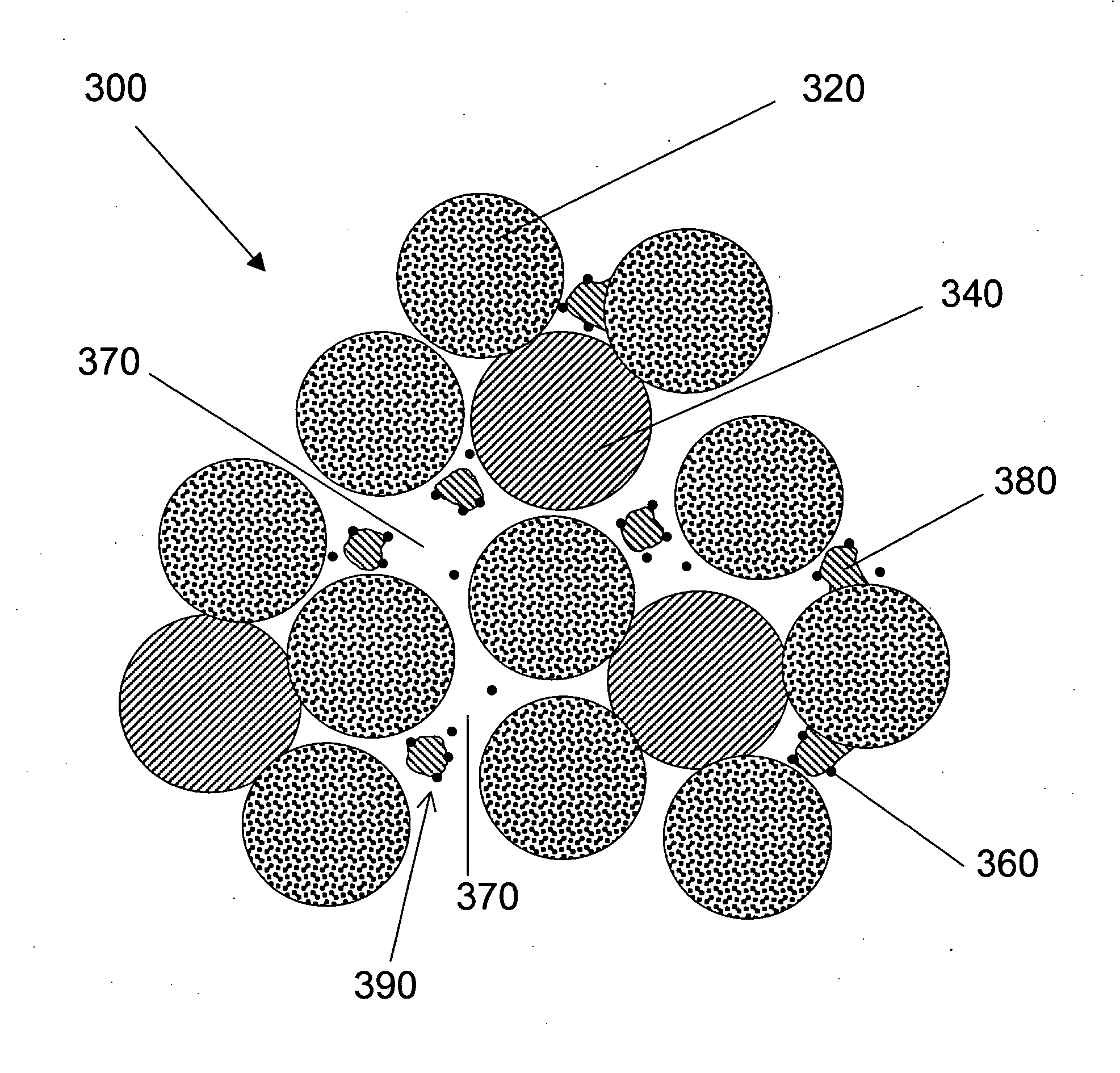Multiple-component binder systems for porous composite blocks
a technology of porous composite blocks and binder systems, applied in separation processes, transportation and packaging, filtration separation, etc., can solve the problem that carbon alone cannot remove all impurities of interest, and achieve the effect of removing contaminants
- Summary
- Abstract
- Description
- Claims
- Application Information
AI Technical Summary
Benefits of technology
Problems solved by technology
Method used
Image
Examples
example 1
One Size Binder Particles
[0059] A porous carbon block was prepared using 70 wt % (weight percent) 80×325 mesh activated coconut carbon, 20 wt % GUR 2105 (very high molecular weight polyethylene, 120 micron average particle size, available from Ticona) binder and 10 wt % lead scavenger (5 μm average particle size). The components were added to a mixer bowl and mixed for 20 minutes at the medium speed setting to achieve a uniform mixture. The bottom puck and center rod were inserted into a cylindrical block mold. The mixture was poured into the cylindrical block mold in a cylindrical pattern to ensure even distribution of the media. The top puck was inserted into the mold, and the full mold was placed in an oven at 245° C. for 40 minutes. The fully heated mold was removed from the oven and placed in a Carver lab press where the required amount of compression was added to produce a porous carbon block capable of 0.7 gpm (gallons per minute) at a water pressure of 60 psi (pounds per sq...
example 2
One Size Binder Particles
[0061] The procedure as described in Example 1 was used to prepare a carbon block containing 75 wt % 80×325 mesh activated coconut carbon, 20 wt % GUR 2105 (very high molecular weight polyethylene, 120 μm average particle size, available from Ticona) binder and 5 wt % lead scavenger (5 μm average particle size). The difference between Example 2 and Example 1 is the addition of 5 wt % activated carbon and the resulting reduction of 5 wt % lead scavenger.
[0062] The porous carbon block removed 89.9% of lead from 120 gallons of challenge water at 60 psi and 0.7 gpm. Turbidity after the initial 1 liter of flow was 3.2 NTU and after 5 liters of flow was 0.9 NTU.
example 3
Two Different Sizes of Binder Particles
[0063] A porous carbon block was prepared using 75 wt % 80×325 mesh activated coconut carbon, 15 wt % GUR 2105 (very high molecular weight polyethylene, 120 μm average particle size, available from Ticona) binder, 5 wt % FN510 (low density polyethylene, 20 μm average particle size, available from Equistar) and 5 wt % lead scavenger (5 μm average particle size). The difference in the components between Example 3 and Example 2 is the addition of 5 wt % FN510 and the resulting reduction of 5 wt % GUR2105. The procedure as described in Example 1 was used except there was a reduction in the oven temperature from 245° C. to 225° C.
[0064] The porous carbon block removed more than 99.9% of lead from 120 gallons of challenge water at 60 psi and 0.7 gpm. Turbidity after the initial 1 liter of flow was 5.5 NTU and after 5 liters of flow was 0.3 NTU.
[0065] Particulars on the porous carbon blocks from the examples are summarized in Table I below. Example...
PUM
| Property | Measurement | Unit |
|---|---|---|
| particle size | aaaaa | aaaaa |
| particle size | aaaaa | aaaaa |
| particle size | aaaaa | aaaaa |
Abstract
Description
Claims
Application Information
 Login to View More
Login to View More - R&D
- Intellectual Property
- Life Sciences
- Materials
- Tech Scout
- Unparalleled Data Quality
- Higher Quality Content
- 60% Fewer Hallucinations
Browse by: Latest US Patents, China's latest patents, Technical Efficacy Thesaurus, Application Domain, Technology Topic, Popular Technical Reports.
© 2025 PatSnap. All rights reserved.Legal|Privacy policy|Modern Slavery Act Transparency Statement|Sitemap|About US| Contact US: help@patsnap.com



